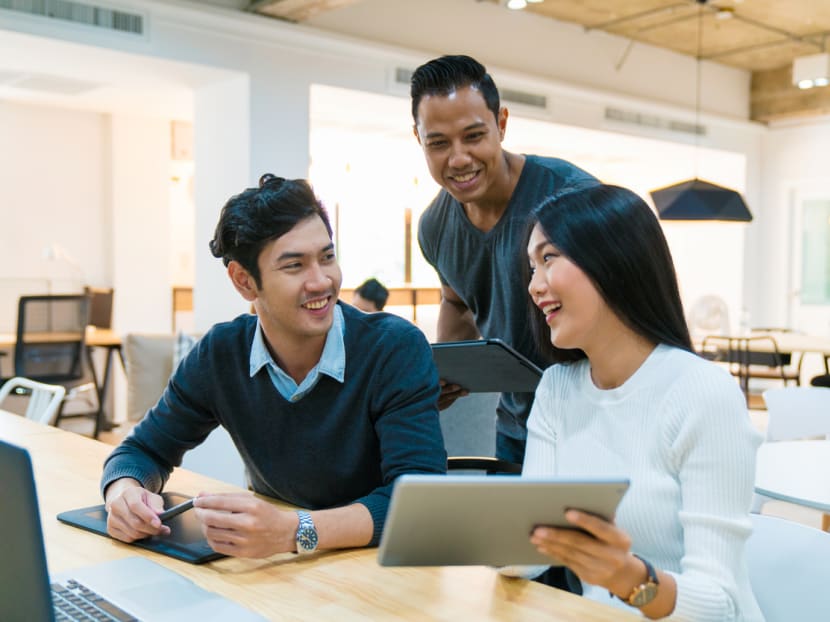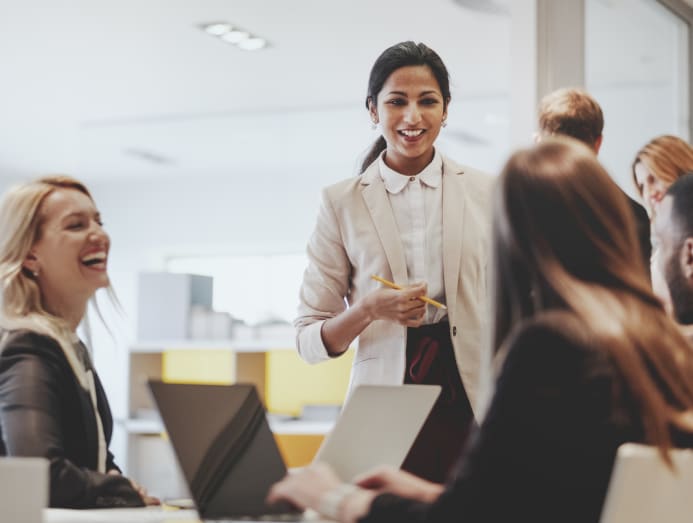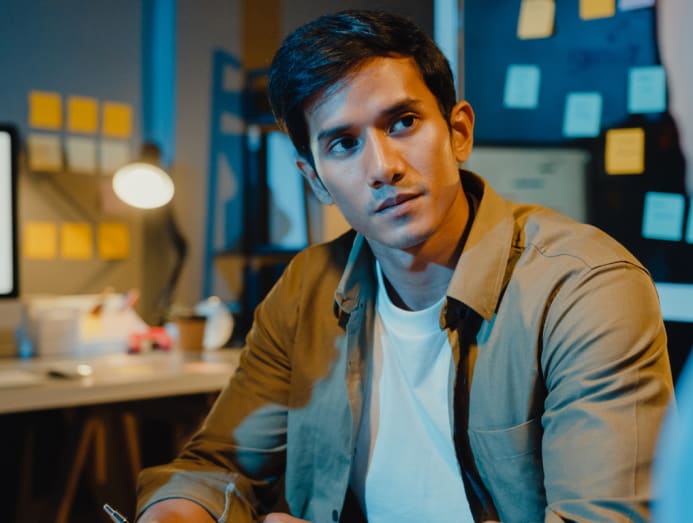Male allyship: What it is, why it's important for gender equality and how women can participate
In a month celebrating women and their contributions to society, CNA Women looks at the role of men in advancing gender equality – and how women can support these efforts.

Qualities of an effective male ally include an awareness of and passion for gender equity, as well as the ability to listen well. (Photo: iStock/JGalione)
No one really can say when the term “male allyship” formally entered our everyday discourse. But with awareness campaigns continuing to grow in number and size across industries around the world, there’s no question that it is here to stay.
But what is it really? How does it advance global efforts towards gender equality? More importantly, what can women do to encourage and support it?
THE ROLE OF A MALE ALLY
It is widely reported that women, who make up roughly half of the world’s population, are a disadvantaged group across the board.
According to global data collated by the United Nations, two-thirds of illiterate adults are women, only 24 per cent of parliament seats are occupied by women, and women earn 23 per cent less than men.
Additionally, women spend three times as many hours as men on unpaid care and domestic work, and one in three women worldwide have experienced physical or sexual violence (mostly from an intimate partner).
While only scratching the surface, these numbers illustrate the urgent need for positive change where gender equality is concerned – a change in which allyship has an active part to play.

A recent research paper about institutional male allyship in Australia offers a broad definition for the word “ally”, often used interchangeably with words like “advocate”, “champion” and “sponsor”: “Allies align themselves with disadvantaged or oppressed groups, and recognise the need for further progress in the journey towards equality.”
“For example, male allies actively confront inequality in interpersonal interactions and intervene to address the structural and institutional dimensions of inequality. Crucially, allies recognise their roles in potentially perpetuating the status quo,” the paper explained.
To play this role effectively, a male ally needs to have several qualities, according to field experts and established allies CNA Women spoke to:
Has an awareness of and passion for gender equity: “A male ally is someone who, first off, understands that a gender equity gap exists, understands that diversity in our work setting and in our world enables stronger results, and understands that more men need to have this understanding so we can be part of the solution,” said Jim Falteisek, managing director at 3M Korea.
“We sometimes encounter the belief that gender equality is a zero-sum game. Yet women’s rights do not take away from men’s rights. Gender equality is an inclusive goal that benefits everyone in a society,” Shailey Hingorani, head of research and advocacy at Singapore gender equality advocacy group AWARE, also said.
Echoing this view, Jamshed M Kazi, representative and liaison to ASEAN UN Women Indonesia, said: “This is not about women or men; it is about crafting a shared vision of human progress for all – it’s about creating a solidarity movement between women and men for the achievement of gender equality.”
Is committed to a long-term effort: An ally needs to be “situationally aware and in it for the long run”, said Shahrany Hassan, founder and director of non-profit organisation The Whitehatters, which runs a campaign against sexual abuse called A Holding Space. Effecting change requires a “cultural mind shift” – it is “not a one-off transaction”, she added.
Is an active listener: “It is important to understand that there is a red line between male allyship and developing what I would call saviour complex. For all male allies, it is first important to be fully cognisant of our own privileges, biases and role, even if sub-conscious, of perpetuating a cycle of discrimination and inequality.
This is not about women or men; it is about crafting a shared vision of human progress for all
“This entails a lot of listening to disadvantaged women and gender diverse groups while withholding judgement, not making assumptions but rather asking them how we can, as men, be most effective allies,” said Jamshed.
Andy Sim, vice-president and managing director for Dell Technologies in Singapore, agreed.
“By listening to women and obtaining a first-hand perspective, men can better understand the challenges that women face, provide the right support and become better advocates for women at the workplace and in everyday life,” he said.
“I remind myself to be open to all opinions when speaking to those around me. At work, I maintain an open-door policy and encourage team members to stop by whenever they would like to chat,” Sim added.
Is willing to speak up and take action: A male ally also has to be able and willing to speak up on gender issues, said Shahrany. He has to “truly listen” and be observant of what is happening around him, to see the wrong and make an effort to make it right, “whether in words or actions”, she said.
“At the basic level, a man (needs to use) inclusive language … and is not afraid to ask (women) about our experiences in his effort to learn,” she added.
Ultimately, they have to “do something within their power to move forward”, said Falteisek.
WHERE TO FIND OUT MORE
The experts shared informational resources where both men and women can do their homework about the needs of the gender equality movement and find ways to take action in their own lives.
A Holding Space: This campaign against sexual violence is a joint initiative between The Whitehatters and local women’s shelter Casa Raudha. The website offers basic information and helplines for victims and allies, and starting April, a new campaign with webinars on how to respond to victims, including male victims of sexual violence, will take place.
HeForShe: Created by UN Women, this solidarity movement offers a library of resources for individuals, companies and businesses to take action for gender equality. It also provides evidence-based solutions that address the most pressing gender issues.
Women’s Empowerment Principles: This resource founded by UN Women and the UN Global Compact offers a set of principles that can guide businesses on promoting gender equality and women’s empowerment in the workplace, marketplace and community. The framework suggests six main stages: Consider, Sign, Activate, Engage, Sustain and Report, and includes a toolkit with resources such as policies, multimedia and templates that companies can use.
CHALLENGES FACED BY MALE ALLIES
Advocacy of any form has its challenges. With male allyship in particular, one of the biggest blocks is “toxic masculinity”.
Toxic masculinity represents “unhealthy norms that are traditionally associated with ‘manhood’”, which have been ingrained into individuals from a young age, said Hingorani.
“Such norms, which include strength and aggression, emotional stoicism, risk-taking, sexual conquest and heteronormativity (a concept that promotes heterosexuality as the “normal” or preferred mode of sexual orientation), contribute to men’s need for dominance and control.
“The pressure to conform to these traits can lead to extreme behaviour that negatively impacts both the men and the people around them,” she added.
Dismantling biases that have not only been internalised personally but also institutionalised is critical. Hingorani urged male allies to first do this, adding that it requires that they “reimagine the traits that are typically associated with men”.

“Being an effective male ally means being prepared to confront uncomfortable truths about one’s past and present actions, and to have the humility to critically reflect on mistakes and course correct,” said Jamshed.
“It is also ultimately about rebalancing centuries-old power dynamics, which cannot be addressed overnight, but small, determined steps can go a long way,” he added.
Beyond unlearning toxic masculinity on an individual level, men can also engage with other men, said Hingorani, by challenging harmful norms and sexist beliefs within their families, workplaces and communities.
“They can call out harmful behaviour from male friends and colleagues, involve themselves in larger advocacy or activism work that dismantles gender structures, and amplify marginalised voices around them to ensure that their own experiences do not take over the discussion,” she said.
Other challenges include apathy, as well as a lack of empathy, said Falteisek.
“(They experience) either apathy or hopelessness – that the situation is too big to have an impact. I think many people on many issues believe that any personal single action won’t make a significant difference. But it does,” he said.
Falteisek said he also senses in his conversations around the gender equity gap that some people feel men are “disadvantaged by programmes promoting gender equity, when in fact there is no data to support that as far as I’m aware”.
Finally, many men may not know how to take action.
“They are unsure how to respond when biases creep in or the avenues they can turn to to fix the problem. Many haven’t been exposed to ‘ally’ training that would help them better understand how to make a positive impact,” said Falteisek.
HOW WOMEN CAN PARTICIPATE
It may help if women examine their own biases as well, said Hingorani, and one productive way to do this is through the lens of intersectionality.
“Class, ethnicity, religion, income, sexual orientation and physical ability are all factors that differentiate people’s experiences. For example, a low-income Indian woman faces different challenges from a low-income Chinese woman, and it’s not helpful to erase those differences when we think about how best to address these two women’s needs,” said Hingorani.
Constantly having to educate others on their challenges can be exhausting for many women, but taking part in open and honest conversations about the female experience can be enlightening for male allies.
To keep it sustainable, women can choose to participate in company-led initiatives such as speed networking events or an informal lunch with a facilitated discussion, said Falteisek.
He also suggested that women “make men feel welcome” and also acknowledge their challenges.
“Be clear that their voices are wanted and needed … Lastly, encourage open discussion of men’s challenges. Just as women find gender stereotypes problematic, male stereotypes can also be damaging. Addressing and validating both sides can create empathy and a catalyst for change,” he said.
CNA Women is a section on CNA Lifestyle that seeks to inform, empower and inspire the modern woman. If you have women-related news, issues and ideas to share with us, email CNAWomen [at] mediacorp.com.sg.









